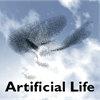通过分布式生命行动者解决领域无关的终身问题。
IF 1.5
4区 计算机科学
Q4 COMPUTER SCIENCE, ARTIFICIAL INTELLIGENCE
引用次数: 0
摘要
介绍了一种基于人工生命原理的领域独立问题解决系统。在DIAS系统中,域的输入和输出维度被布置在一个空间介质中。一群参与者,每个人只看到这个媒介的一部分,在其中集体解决问题。流程独立于领域,可以通过不同类型的参与者来实现。通过对各种问题域的一系列实验,表明DIAS能够解决具有不同维度和复杂性的问题,不需要对新问题进行超参数调整,并且表现出终身学习,即快速适应问题域的运行时变化,并且比标准的非集体方法做得更好。因此,DIAS证明了ALife在构建可伸缩的、通用的和自适应的问题解决系统中的作用。本文章由计算机程序翻译,如有差异,请以英文原文为准。
Domain-Independent Lifelong Problem Solving Through Distributed ALife Actors
A domain-independent problem-solving system based on principles of Artificial Life is introduced. In this system, DIAS, the input and output dimensions of the domain are laid out in a spatial medium. A population of actors, each seeing only part of this medium, solves problems collectively in it. The process is independent of the domain and can be implemented through different kinds of actors. Through a set of experiments on various problem domains, DIAS is shown able to solve problems with different dimensionality and complexity, to require no hyperparameter tuning for new problems, and to exhibit lifelong learning, that is, to adapt rapidly to run-time changes in the problem domain, and to do it better than a standard, noncollective approach. DIAS therefore demonstrates a role for ALife in building scalable, general, and adaptive problem-solving systems.
求助全文
通过发布文献求助,成功后即可免费获取论文全文。
去求助
来源期刊

Artificial Life
工程技术-计算机:理论方法
CiteScore
4.70
自引率
7.70%
发文量
38
审稿时长
>12 weeks
期刊介绍:
Artificial Life, launched in the fall of 1993, has become the unifying forum for the exchange of scientific information on the study of artificial systems that exhibit the behavioral characteristics of natural living systems, through the synthesis or simulation using computational (software), robotic (hardware), and/or physicochemical (wetware) means. Each issue features cutting-edge research on artificial life that advances the state-of-the-art of our knowledge about various aspects of living systems such as:
Artificial chemistry and the origins of life
Self-assembly, growth, and development
Self-replication and self-repair
Systems and synthetic biology
Perception, cognition, and behavior
Embodiment and enactivism
Collective behaviors of swarms
Evolutionary and ecological dynamics
Open-endedness and creativity
Social organization and cultural evolution
Societal and technological implications
Philosophy and aesthetics
Applications to biology, medicine, business, education, or entertainment.
 求助内容:
求助内容: 应助结果提醒方式:
应助结果提醒方式:


